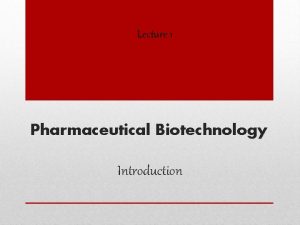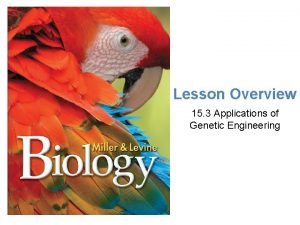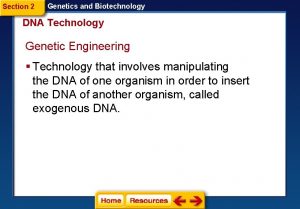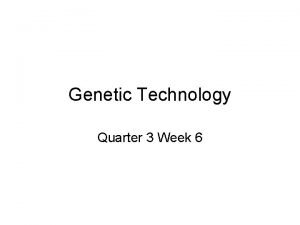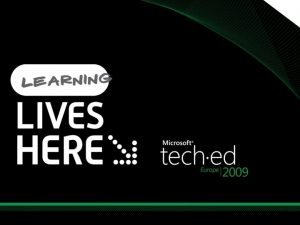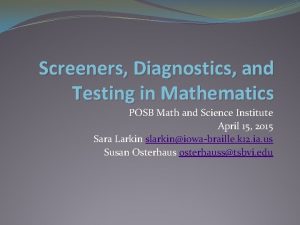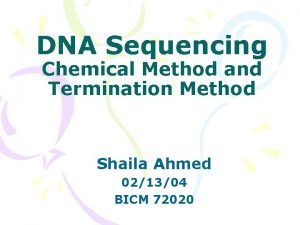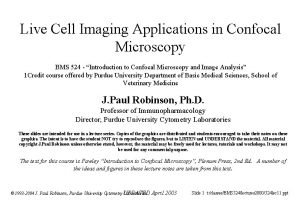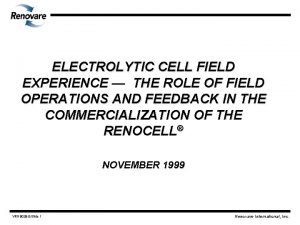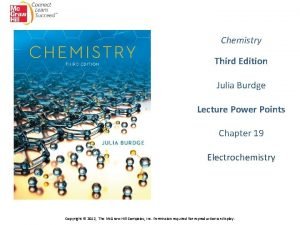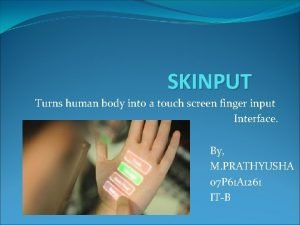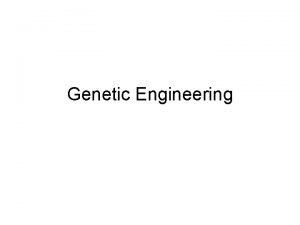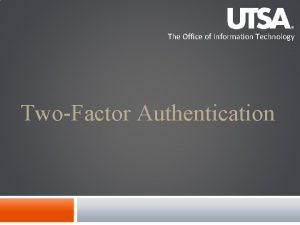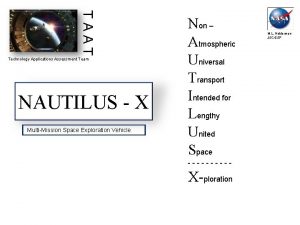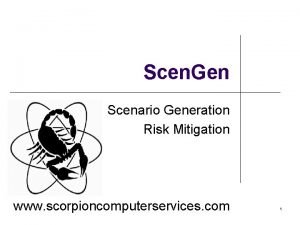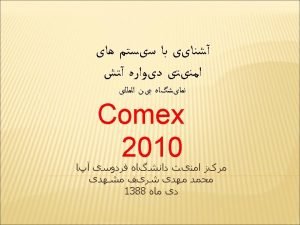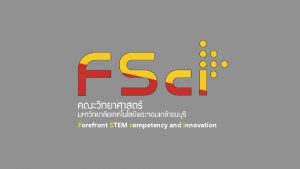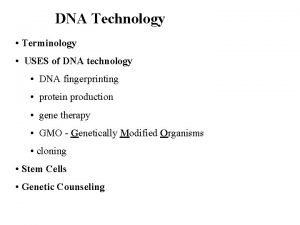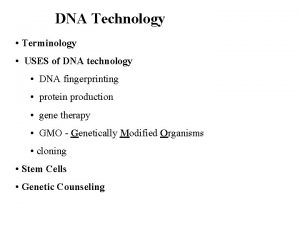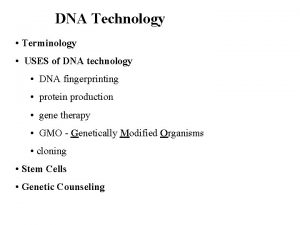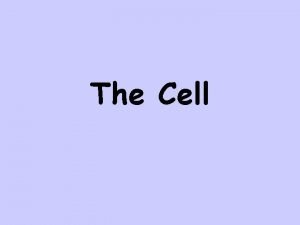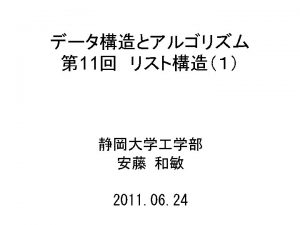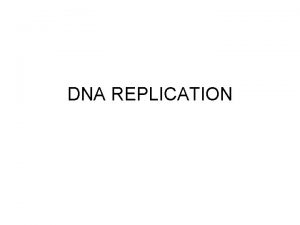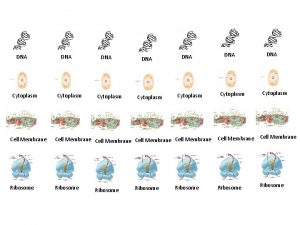Applications of DNA Technology DNA technology forefront cell













































- Slides: 45

Applications of DNA Technology DNA technology, forefront, cell biology, potential, solve problems known, future potential, discovered. Main areas studied: • Human Genome project • Human Therapeutics • Forensic Science • Agriculture

Human Genome Project 15 year project (mainly USA, Europe and Japan) Map genome Isolate genes Determine function of genes Compare to other species maps Explore ethical, social, legal issues

Progress 2004 genome mapped, nucleotide sequence for every human chromosome known. 3 billion nucleotide base pairs in human DNA 1 - 2% (20 - 40 thousand genes) of the 3 billion is essential for protein coding sequence (extrons). 98% regulation of gene transcription or unknown function (such as spacers between genes or in genes (introns))

DNA analysis, complicated, time consuming, greatly enhanced by new technology especially computers. 3 main methods for DNA analysis Genetic (linkage) mapping Physical mapping DNA sequencing

Genetic linkage mapping Locates relative position of genes on chromosomes, cross over values (COV) or recombination frequencies in meiosis. • Used for inherited characteristics • Used for gene mutations that cause genetic disorders • use short tandem repeats (micro-satellites) of repeating base sequences e. g. CACACA of variable length

Physical mapping Increased resolution (detail) needed. Starting with long pieces of DNA and working down. This needed new technology and techniques including: • Cutting DNA up using restriction endonuclease enzymes • Cloning DNA using micro-organisms (bacteria) • Identifying genes or micro-satellites using nucleic acid probes • Use chromosome walking to sequence genetic markers

Restriction mapping DNA fragments are generated using restriction endonucleases enzymes. Enzymes recognise specific short sequences of base pairs usually (4 - 8 nucleotides long). Different enzyme different sequence (100 or so enzymes from bacteria) Fragments are identified by size or by attaching a flourescent tag (were radioactive) When put back with unzipped DNA strand these short tagged sections would reveal location of sequence of nucleotides (chromosomal walking). Many repeats with different lengths of DNA gave overlapping picture of sequence of nucleotides

Polymerase Chain Reaction (PCR) Advances in producing cloned DNA Alternative method of producing more DNA is the polymerase chain reaction (PCR). No living cells are needed, machines produce in hours what micro-organisms would have done in days. Very useful where small quantities of DNA are available such as samples of hair with follicle, saliva, blood or semen.

Using PCR to clone DNA • provide DNA to be copied, • four bases (as deoxyribose nucleotide phosphates) • DNA Taq polymerase enzyme (heat stable), • two primers (short lengths of single strand synthetic DNA complementary to the 3' end to be copied)

Using PCR to clone DNA o • Separate strands of DNA by heating to 95 C for 30 seconds. o • Add primers and cool to 55 C for 20 seconds so primers can anneal (join) at correct sequence. o • Heat to 75 C to allow DNA Taq polymerase enzyme to join nucleotides to corresponding bases. • Allow sequence to repeat itself automatically to produce many clones of original DNA. • Fully automated process


DNA sequencing Once gene position had been worked out, base pair sequence was then determined using a process similar to PCR and gel electrophoresis. A machine capable of building DNA sequences like PCR is used but altered tagged nucleotides are used that can halt the replication process. The process is allowed to run for increasing lengths of time giving many different lengths of DNA. These are then separated out using gel electrophoresis sensitive enough to separate fragments differing by only 1 nucleotide.



DNA sequencing Technology now allows sequencing of DNA fragments very quickly. Computer hardware and software much more sophisticated and improving. For example gel electrophoresis is now obsolete and other techniques are used.

Genome studies Put simply the size of organism relates to size of genome, but this is not always the case there are exceptions. Reasearch done on mainly bacterium (E. coli), yeast (S. cerevisiae), nematode worm (C. elegans), fruit fly (D. melanogaster) and mouse (M. musculus). There are many shared genes and DNA sequences between organisms. Humans and chimpanzees 98% identical DNA sequences.

Genome Sizes Organism genome size number of (Mb) genes E. coli 4. 6 4, 405 S. cerevisiae 12. 1 5, 800 D. melanogaster 150 12, 200 H. sapiens 3, 000 30, 000 N. tabacun 4, 500 43, 000

Human Therapuetics Congenital abnormalities (genetically based diseases) Single gene defects (monogenic trait) 5, 000 described and characterised as either: • autosomal dominant • autosomal recessive • X linked (most are recessive if X linked) Multiple gene defects (polygenic trait)

Detecting Genetic Disorders Disease symptoms and historical information Family relationships/pedigree analysis to determine nature (e. g. dominant/recessive/x linked) Monogenic trait identified with gene analysis techniques: gene mapping, physical mapping, DNA sequencing used to determine location and sequence of base and its effects. Treatments can then be derived and genetic counselling given Cystic fibrosis and Duchennes muscular dystrophy

Cystic Fibrosis Autosomal recessive monogenic trait (affecting 1 in 2, 000) Gene of membrane carrier protein of 1, 480 aa (complex structure including 2 transmembrane domains, 2 ATP binding domains and a regulatory region). Mutations in gene give defective ion transport system (epithelial cells not fully hydrated), sticky mucus in the lungs. Major symptoms include inflammation of lung tissue and persistant bacterial infections Other problems include defects in pancreatic function, infertility and increased risk of diabetes.

Diagnosis - abnormally salty sweat. Quality of life reduced/life expectancy 30 years. Defective CF gene carrier frequency of 1 in 22. In parents where both carry defect 1 in 4 chance of any child receiving both recessive alleles. Mapped to chromosome 7. 550 mutations described so far. Most common is deletion of 3 base pairs removing 1 amino acid ((F 508) Deletion, phenylalanine, 508 th amino acid) Defective protein does not fold properly and does not reach membrane location.

Duchennes Muscular Dystrophy • X linked affecting 1 in 3, 300 boys. • progressive wasting of muscles, confinement to wheel chair in teenage years. • Wasting, paralysis, respiratory difficulties. • life expectancy 30 years (approx). • gene found in 1987 • protein dystrophin 3, 685 aa. Normal function is to link cytoskeleton with muscle cell membrane (sarcolemma) in muscle cells.

Screening tests When? , Why? , How? • best done before conception • voluntary but only usually done on families with a history of either • 25% chance of having an affected child if both are carriers • prenatal genetic testing (amniocentesis or chorionic villus (placenta) sampling), only if parents willing to have an abortion • postnatal tests: excessively salty sweat for CF and raised creatine kinase levels for DMD.

Uses of Gene therapy Use of genes to treat illnesses by: • killer genes to target tumours so that only the cells with the genes are affected by drug treatment. • Replacing defective genes in cells • Inserting extra genes to have a beneficial effect

Use of Gene Therapy Use of gene therapy very complex: • normal gene must be available in cloned form • affected cells must be accessible either in vivo (patient) or in vitro (tissue culture) then transplanted • suitable vehicle (vector) for delivery of gene • gene functions normally in target cells

Use of Gene Therapy Vectors for delivery include: • Liposomes (hollow membrane sphere surrounding a plasmid). The plasmid delivers the DNA to the target cells. Problems are that plasmids do not incorporate themselves into the chromosomes so short term expression. • Virus (recombinant virus) replication genes are removed and space filled with therapuetic gene. Virus can then integrate its genetic material with host cell. Problems of immune response by host organism and specific host cells invaded by virus particles

Gene Therapy Ethics • somatic cells? • germ cells? • Counselling testing for defects treatment of defects

Forensic uses for DNA Technology Criminal Paternity Immigration

Criminal DNA 'fingerprinting' developed in 1984 Uses fragment size of DNA molecules to give a banding pattern from gel electrophoresis. Process is: • Isolate DNA • Digest with enzymes • Transfer DNA fragments to filter • Bind a labelled probe of DNA to known locations, run gel electrophoresis • Analyse banding • Single locus probes

Alec Jeffreys DNA banding patterns

Probe • single locus probes • bind to 1 complimentary sequence in genome. • 2 bands are visible in autoradiogram (paternal and maternal).

DNA profiling now used more often than DNA fingerprinting. Process is: isolate DNA sample amplify (clone) using PCR but use a primer that will bind to a specific short tandem repeat with 3 or 4 different DNA primers label the cloned DNA with fluorescent dyes. Analyse using automated DNA sequencer to produce a chart with peaks showing length of each cloned fragment look for matching peaks in samples analysed

DNA profiling

Reliability of Techniques Quality control: • recording of samples • cross checking of procedures • contamination by other DNA during PCR • Inspection of procedures Public confidence Legal fortitude

Agriculture Great potential Applied to both animals and plants Genetic modification to improve species which is benefit to producer and consumer Plants resistance to disease, drought, herbicides, pesticides increasing yield/growth, fruit shelf life, novel products - oils/plastics, vaccines, antibodies Animals increasing yield/growth, organs for transplant Problems acceptance by public consequences of genetic modification

Genetic Modification TRANSGENIC organisms genes for the desired characteristic from one organism inserted into the hosts DNA. Genetic material to future generations. (Revise Recombinant DNA technology to produce Insulin from E. coli bacteria)

Transgenic plants Requirements vector to insert cloned DNA fragment into plant cell genome method of regenerating whole plants so all cells carry the transgene.

Tissue culture in plants 1 vector is Agrobacterium tumefaciens (soil bacteria). Can insert DNA from a plasmid into plant cells Ti plasmid used (usually induces crown gall disease in plants) (Ti = tumour inducing). Ti plasmid carries T-DNA a region that integrates with plant cell genome. Ti plasmid reduced in size and target gene incorporated into TDNA region. The smaller plasmids lack the tumour producing effects.

Producing a transgenic plant

Transgenic plant examples Tomato plants - delayed ripening by inhibiting the production of ethylene (normally produces ripening), fruit stays firmer longer. Biotech company CALGENE produce Flavr Savr tomato. Insect resistance by inserting gene for insecticidal protein. Nitrogen fixation in non legumes Cereals/grasses unfortunately are not affected by Ti plasmid, so new insertion methods are needed.

Problems with transgenic plants Monsanto produced soya beans resistant to round up weed killer. So what?

Transgenic Animals Transgenic animals include: sheep that can make antitrypsin in milk to treat emphysema. Another important use of DNA Technology and animals are products that are given to animals including hormones, antibodies, vaccines, cellulase produced by genetic engineering

Bovine growth hormone as an example Bovine somatotrophin (BST) produced by Monsanto Grown using bacteria and injected into cattle in America Increases milk yield by 10% Should not effect any one who eats meat. Public concern over containment of the hormone so importation of meat or from cattle treated with this is banned

Producing b. ST to give to cows.

Future Questions Transgenic crops good/bad? Information? Choices? Manipulation by big companies? Ensuring food supplies? Future? vaccine production disease diagnosis pharmaceutical proteins xenotransplantation (organs grown in pigs)
 Recombinant dna technology applications
Recombinant dna technology applications Recombinant dna technology applications
Recombinant dna technology applications Recombinant dna technology applications
Recombinant dna technology applications Recombinant dna technology applications
Recombinant dna technology applications Recombinant dna technology applications
Recombinant dna technology applications Francesco giorgini
Francesco giorgini Microsoft forefront protection 2010 for exchange server
Microsoft forefront protection 2010 for exchange server Forefont client security
Forefont client security Forefront security solutions
Forefront security solutions Forefront screeners
Forefront screeners Forefront identity manager roadmap
Forefront identity manager roadmap Multi engine antivirus
Multi engine antivirus Microsoft forefront security for exchange server
Microsoft forefront security for exchange server Microsoft forefront
Microsoft forefront Dna sequencing applications
Dna sequencing applications Live cell imaging applications
Live cell imaging applications Renocell
Renocell Galvanic vs electrolytic cell
Galvanic vs electrolytic cell Cell notation
Cell notation Applications of electrolytic cell
Applications of electrolytic cell Replication
Replication Bioflix activity dna replication dna replication diagram
Bioflix activity dna replication dna replication diagram Coding dna and non coding dna
Coding dna and non coding dna What role does dna polymerase play in copying dna?
What role does dna polymerase play in copying dna? Dna and genes chapter 11
Dna and genes chapter 11 Skinput
Skinput Genetically modified crops have
Genetically modified crops have Jazz multisensor
Jazz multisensor Technology applications
Technology applications Blue eye technology applications
Blue eye technology applications Technology applications teks
Technology applications teks Public affairs directorate oxford
Public affairs directorate oxford Technology applications
Technology applications Oms ontario
Oms ontario 8-5 practice dot and cross products of vectors in space
8-5 practice dot and cross products of vectors in space Technology applications middle school lessons
Technology applications middle school lessons Contoh group technology
Contoh group technology Information technology applications
Information technology applications Technology applications middle school
Technology applications middle school Technology applications
Technology applications Technology applications examples
Technology applications examples Information technology applications
Information technology applications Technology applications teks
Technology applications teks Technology applications
Technology applications Technology applications program office
Technology applications program office Technology applications
Technology applications
